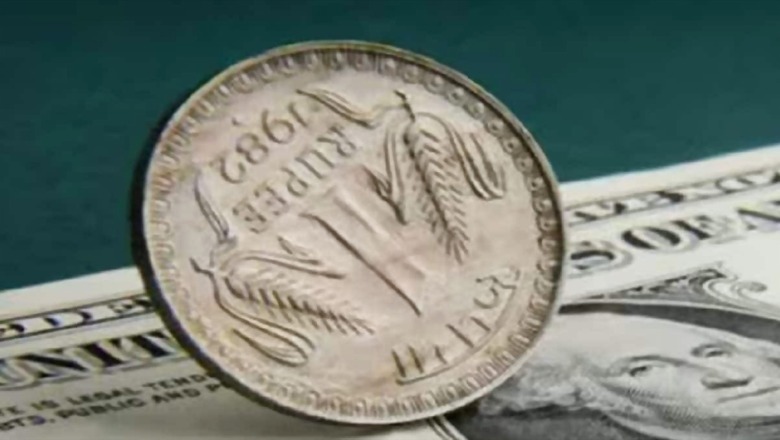
views
The Indian rupee experienced a significant drop on June 20, Thursday, plunging by 17 paise to hit a two-month low of 83.61 per dollar. This decline occurred despite robust buying activity in the capital market. The domestic currency’s fall is part of a broader weak trend for the rupee, exacerbated by dollar strength, Chinese Yuan weakness and a surge in crude oil prices amid fresh geopolitical tensions in Ukraine.
Experts also said Vodafone’s stake sale in Indus Tower on Wednesday was expected to be spent in repayment of India loan but it turned out to be Euro loan. So, the amount went out of India, which put strain on the rupee.
At the interbank foreign exchange market, the rupee opened at 83.43 and reached an intra-day high of 83.42 against the US dollar. During the session, it hit an all-time low of 83.68 before settling provisionally at 83.61, marking a steep 17 paise decline from its previous close.
Rupee At 2-Month Low: Key Reasons
Anil Kumar Bhansali, head of treasury and executive director of Finrex Treasury Advisors LLP, said, “The rupee, which was range-bound since October 2023 with a high of 82.64 and a low of 83.57, suddenly weakened to 83.67 on Thursday. The main reasons for the same were general dollar strength, weakness of Chinese Yuan, equity-related outflows and crude buying by oil companies.”
The level of 83.67 was a new low for INR and 83.6525 a new closing low. The rupee had been hovering between 82.50 and 83.50 for a long time since October 2023 and it looks like that the RBI has allowed the weakness after the elections as it broke 83.60 and closed above it, he added.
Explaining the impact of Vodafone’s 18% stake sale in Indus Tower on the Indian rupee, Bhansali said, “Vodafone’s stake sale in Indus Tower was expected to be repayment of India loan but it turned out to be Euro loan. So, the amount went out of India, which put a strain on the rupee.”
British telecom player Vodafone on June 19 said it has sold an 18 per cent stake in Indus Towers for 1.7 billion euro (about Rs 15,300 crore). “The placing raised Rs 153.0 billion (1.7 billion euro) in gross proceeds, which will be used to substantially repay Vodafone’s existing lenders in relation to the outstanding bank borrowings of 1.8 billion euro secured against Vodafone’s Indian assets,” Vodafone said in a note.
Jateen Trivedi, Vice-President and Research Analyst (Commodity and Currency) at LKP Securities, commented, “The rupee fell to a record low below 83.65 against the dollar during the session, despite significant buying in the capital market. The overall market trend remains broadly weak for the rupee, albeit at a slower pace compared to peers.”
Trivedi also noted that upcoming weekly jobless data from the US will influence dollar trends, but the rupee volatility is expected to persist within the 83.45-83.75 range.
Anuj Choudhary, Research Analyst at Sharekhan by BNP Paribas, attributed the rupee’s depreciation to a strong US dollar and mixed to weak performance in Asian markets. “Traders will be looking at US weekly unemployment claims, building permits, the Philly Fed manufacturing index, housing starts, and current account data for cues. The USD-INR spot price is expected to trade between Rs 83.30 and Rs 83.80.”
Meanwhile, the dollar index, which measures the greenback’s strength against a basket of six currencies, was up by 0.21 percent, trading at 105.10.
The US dollar’s strength was linked to elevated geopolitical tensions, with Russia resuming aerial attacks on Ukraine’s power grid and Kyiv’s forces targeting Russian oil facilities with drone strikes.
Pranav Mer, Vice-President and EBG (Commodity & Currency Research) at JM Financial Services Ltd, explained, “Oil prices remain firm above $80 per barrel in the overseas market, supported by bullish demand forecasts and higher US fuel demand during the summer driving season. However, gains are limited by higher global oil inventories.”
Crude Oil, FPI Inflows
Brent crude futures, the global oil benchmark, edged up 0.18 percent to $85.22 per barrel.
In domestic equity markets, the 30-share BSE Sensex climbed 141.34 points, or 0.18 percent, closing at a new peak of 77,478.93 points. Similarly, the broader NSE Nifty rose by 51.00 points, or 0.22 percent, reaching a lifetime high of 23,567.00 points.
Foreign Portfolio Investors (FPIs) were net buyers in the capital markets on Wednesday, purchasing shares worth Rs 7,908.36 crore, according to exchange data.


















Comments
0 comment